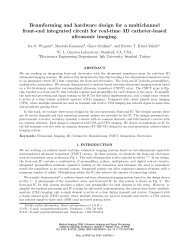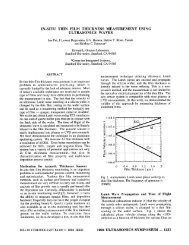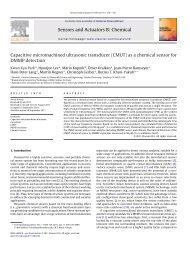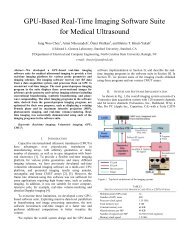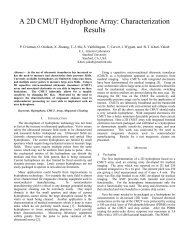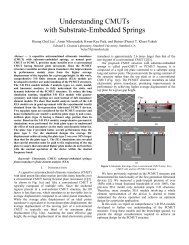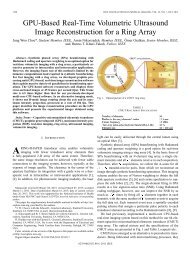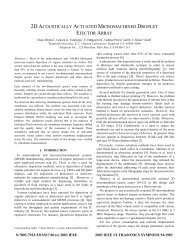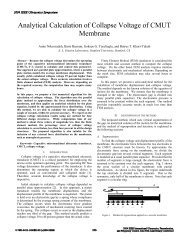Propagation in Finite Anisotropic Plates of Diffracting Scalar Waves
Propagation in Finite Anisotropic Plates of Diffracting Scalar Waves
Propagation in Finite Anisotropic Plates of Diffracting Scalar Waves
Create successful ePaper yourself
Turn your PDF publications into a flip-book with our unique Google optimized e-Paper software.
<strong>Propagation</strong> <strong>in</strong> F<strong>in</strong>ite <strong>Anisotropic</strong> <strong>Plates</strong><br />
<strong>of</strong> Diffract<strong>in</strong>g <strong>Scalar</strong> <strong>Waves</strong><br />
P-E. M. Roche B.T. Khuri-Yakub<br />
E.L. G<strong>in</strong>zton Lab., Stanford University<br />
Stanford, CA<br />
ABSTRACT<br />
The model developed <strong>in</strong> this paper allows to<br />
predict the propagation <strong>of</strong> Lamb waves <strong>in</strong> an<br />
anisotropic wafer. More generally it can account<br />
for the l<strong>in</strong>ear dispersive propagation <strong>of</strong> scalar<br />
waves <strong>in</strong> an anisotropic and f<strong>in</strong>ite plate and for<br />
any local alteration <strong>in</strong> the displacement component<br />
<strong>of</strong> the Lamb Wave. The validation has been done<br />
us<strong>in</strong>g a solid-solid contact as an emitter-receiver.<br />
INTRODUCTION<br />
The resolution <strong>of</strong> the wave propagation<br />
equation <strong>in</strong> an anisotropic plate, like a wafer, is<br />
rendered imprecise, <strong>in</strong> practice, by the fact that<br />
plate dimension is f<strong>in</strong>ite. We propose hereafter a<br />
method <strong>of</strong> resolution which <strong>in</strong>troduce the border<br />
diffraction and allows to predict Lamb wave<br />
propagation <strong>in</strong> an anisotropic and dispersive<br />
wafer.<br />
ENERGY ENHANCEMENT FACTOR<br />
Accord<strong>in</strong>g to the Fourier theory, the l<strong>in</strong>ear<br />
wave equation can be reduced to the harmonic<br />
equation [U. Let us name u(M) complex<br />
amplitude <strong>of</strong> the harmonic solution U(M,t), o the<br />
angular frequency, t the time and M a po<strong>in</strong>t <strong>of</strong> the<br />
plate referred to an orig<strong>in</strong> 0 <strong>of</strong> the plate by its<br />
polar coord<strong>in</strong>ates (r,P). k will be the wave<br />
vector.<br />
Consider<strong>in</strong>g a 2D scalar wave<br />
propagat<strong>in</strong>g <strong>in</strong> an isotropic medium issued from<br />
an harmonic po<strong>in</strong>t source located at the orig<strong>in</strong> 0.<br />
The wave equation reduces, <strong>in</strong> polar coord<strong>in</strong>ates,<br />
to the Bessel equation :<br />
a2u<br />
1 aU<br />
- + -- + ki.u = 0<br />
dr2<br />
r ar<br />
In our problem, accord<strong>in</strong>g to K.F. Graff<br />
[2], the solution is reduced to the Hankel function<br />
Ho(l)(ko.r) modulo a complex factor that to<br />
simplify we will assume equal to one. The<br />
convergence <strong>of</strong> this solution allows to use the<br />
asymptotic form:<br />
P.<br />
. exp(i.k,.r)<br />
<strong>Anisotropic</strong> medium. If a and p are the<br />
respective angles <strong>of</strong> the wave vector k and the<br />
energy velocity vector V E at any ~ po<strong>in</strong>t ~ M, a ~ ~ ~<br />
cont<strong>in</strong>uous function D relates this two angles, as<br />
a consequence, any harmonic signal propagat<strong>in</strong>g<br />
<strong>in</strong> the P direction can be resolved <strong>in</strong> a sum <strong>of</strong><br />
signals with phase k(ai).r - ut, where the ai are<br />
the antecedents <strong>of</strong> p <strong>in</strong> the previous function.<br />
Formulation. Consider a po<strong>in</strong>t source<br />
generat<strong>in</strong>g wave vectors k(a) isotropically and<br />
the slowness curve, - locus <strong>of</strong> the extremity <strong>of</strong> the<br />
s(a)=k(a)/o vectors, when the a varies. We<br />
notice that whatever the po<strong>in</strong>t the energy velocity<br />
vector rema<strong>in</strong>s always orthogonal to this curve.<br />
So the two directions are always related by:<br />
P=a-Arctg(:) (3)<br />
1051-0117/94/0000-0679 $4.00 0 1994 IEEE<br />
1994 ULTRASONICS SYMPOSIUM - 679
i) If the D function is a bijective relation between<br />
a and p, all the energy radiated <strong>in</strong> the angular<br />
sector [PAP, p+dp 3 results <strong>of</strong> the energy <strong>of</strong> the<br />
waves whose wave vectors are po<strong>in</strong>t<strong>in</strong>g <strong>in</strong> the<br />
angular sector [a-da,a+da]. Then energy<br />
density <strong>in</strong> the p direction is proportional to<br />
da/dp. So, the energy enhancement factor <strong>of</strong><br />
H.J. Maris [3], E(P) = d%p , can be analyticaly<br />
expressed:<br />
1 E(P)=[l+ s'"+ s.slt A<br />
(4)<br />
SI2+ s2<br />
s' and s" are respectively the first and second<br />
derivative <strong>of</strong> s(a) with respect to a.<br />
ii) If D is not a bijective function, the different<br />
factors El, E2 .. associated with the different<br />
directions al, a2 .. <strong>of</strong> which p is the image can<br />
be def<strong>in</strong>ed and summed.<br />
ANISOTROPIC PROPAGATION FORMULA<br />
Us<strong>in</strong>g these results on anisotropy <strong>in</strong> an<br />
emitter-receiver configuration, the expected<br />
received signal v(M) is:<br />
v(M) = m.f(r,P).exp(i.k(a).OM) (5)<br />
with f(r,p) E % an unknown function.<br />
i) If p has only one antecedent a through D.<br />
2<br />
So a general solution for the signal received <strong>in</strong> M<br />
from the source 0 <strong>in</strong> an anisotropic medium with<br />
a is the p antecedent by D is:<br />
DIFFRACTION BY THE EDGES<br />
Focus our attention on the diffraction by<br />
the edge. Dur<strong>in</strong>g reflection, the diffraction occurs<br />
on an <strong>in</strong>f<strong>in</strong>itely small element <strong>of</strong> the free edge part<br />
<strong>of</strong> the plate.<br />
i) Isotropic medium. The phenomenon is similar<br />
to an aperture diffraction, Solutions <strong>of</strong> thewave<br />
equation (1) satisfy u(r,0,z) = u(0,r) and<br />
g(r,e,z) = HL')(k.r). Us<strong>in</strong>g the Green's formula<br />
<strong>in</strong>/on a closed cyl<strong>in</strong>drical surface A (Figure 2 ):<br />
fig.2<br />
ii) If p has several antecedents ai, a2 ... , the<br />
received signal v(M) is the sum <strong>of</strong> similar<br />
expressions, one for each ai .The f<strong>in</strong>al result for<br />
V(M) is :<br />
leads to<br />
680 - 1994 ULTRASONICS SYMPOSIUM
From a Physical po<strong>in</strong>t <strong>of</strong> view, u(0) is the<br />
signal diffracted <strong>in</strong> 0 and the sommation can be<br />
achieved us<strong>in</strong>g solely the knowledge <strong>of</strong> the u(M)<br />
signal values on the contour. By a change <strong>in</strong><br />
coord<strong>in</strong>ates, 0 can represent any <strong>of</strong> the po<strong>in</strong>ts on<br />
the wafer where the signal amplitude is wanted to<br />
be known. This leads to the new genereral<br />
expression:<br />
and with the asymptotic expressions <strong>of</strong> the Hankel functions :<br />
2 ei.k.r*<br />
U(o)=_J In:, --(<br />
.J;; &<br />
ei.k.r COS ei + COS e,<br />
2<br />
Now we can use the diffraction formula<br />
(10) to predict the diffract<strong>in</strong>g reflection <strong>of</strong> a<br />
signal, jo<strong>in</strong>ed to the properties <strong>of</strong> an apertureedge,<br />
Figure 5<br />
$K<br />
ii) <strong>Anisotropic</strong> -- medium. - --- Adapt<strong>in</strong>g (lo), the<br />
signal received <strong>in</strong> M from a po<strong>in</strong>t source 0 is:<br />
For any unitary vector n:<br />
&/an &-,/E@) k(a).cos(e).H{')(k(a).OM)<br />
k<br />
\<br />
.<br />
Figure 4<br />
And with the symbols <strong>of</strong> Figure 4,we propose the<br />
follow<strong>in</strong>g new diffraction formula for an<br />
anisotropic medium. :<br />
EXPERIMENTAL VALIDATION<br />
The experimental arrangement consists<br />
<strong>of</strong> a PZT-SH 230 kHz 40% bandwidth<br />
transducer, bounded at the top <strong>of</strong> a quartz p<strong>in</strong>.<br />
The other end <strong>of</strong> the D<strong>in</strong>, rounded to a radius <strong>of</strong><br />
I -<br />
100 pm, is go<strong>in</strong>g to be <strong>in</strong> direct contact with the<br />
wafer.This shape garanties a sufficient coupl<strong>in</strong>g<br />
coefficient. We evalute changes <strong>in</strong> the squared<br />
amplitude <strong>of</strong> the received signal when the<br />
receiver rod describe a circle around the emitter.<br />
Bursts formed with 3 to 7 cycles have been<br />
used as excitation signal.Pressure applied to the<br />
contact p<strong>in</strong>-wafer may changes the coupl<strong>in</strong>g<br />
coefficient and consequently the amplitude <strong>of</strong><br />
the signals. To dismiss this effect, a second<br />
fixed emitter is used to make a calibration <strong>of</strong><br />
pressure.<br />
Experimental data were taken on a 15 cm<br />
wafer for barious distance emitter-receiver. A<br />
comparison with theoritical results are presented<br />
(see Figure). Results are quite accurate.We have<br />
also checked than a 3% anisotropy <strong>of</strong> the<br />
amplitude mode <strong>in</strong> Si <strong>in</strong>volves a factor 2 <strong>in</strong> the<br />
energy anisotropy.<br />
1994 ULTRASONICS SYMPOSIUM - 681
ALG0FUTI-M FOR A SIMULATION<br />
A numerical simulation has been achieved to<br />
predict the transmission <strong>of</strong> any signal through the<br />
plate, between a po<strong>in</strong>t shaped-emitter to a po<strong>in</strong>t<br />
shaped-receiver. The correspond<strong>in</strong>g transfert<br />
function H(f) has been computed. H(f) was<br />
decomposed <strong>in</strong> its different contributions: the<br />
direct signal Ho(f), the first reflection signal<br />
H 1(f) the multiple reflection signals H2(f),<br />
H3( f)...<br />
CONSEQUENCE<br />
Cutt<strong>in</strong>g the <strong>in</strong>tegration <strong>of</strong> equation (12)<br />
<strong>in</strong>to different parts accord<strong>in</strong>g to the edge we can<br />
roughly divide H(f) <strong>in</strong>to terms account<strong>in</strong>g for the<br />
propagation <strong>in</strong>to specific regions <strong>of</strong> the plate. The<br />
received signal can be seen as a superposition <strong>of</strong><br />
pieces <strong>of</strong> signal correspond<strong>in</strong>g ma<strong>in</strong>ly to one<br />
region.<br />
Suppose an <strong>in</strong>crease <strong>of</strong> the temperature <strong>in</strong><br />
a region <strong>of</strong> the plate. The wave velocity decreases<br />
<strong>in</strong>troduc<strong>in</strong>g a delay, mostly on the signal<br />
contribution com<strong>in</strong>g from this region. A track <strong>of</strong><br />
the delay <strong>in</strong> the signal <strong>of</strong> each piece can be done<br />
from an experimentally received observation and<br />
allows detection <strong>of</strong> the local variations:<br />
temperature, thickness ... The simulated data<br />
could be used to do some k<strong>in</strong>d <strong>of</strong> adapted filter<strong>in</strong>g<br />
<strong>of</strong> an experimental signal.<br />
0<br />
CONCLUSION<br />
We have developped theoritical calculation<br />
for diffraction <strong>in</strong> a 2D isotropic medium and<br />
found an explicit expression <strong>of</strong> the enhancement<br />
factor <strong>in</strong> 2D as a fonction <strong>of</strong> the wave vector<br />
angular dependence.<br />
We present an approximation for<br />
diffraction <strong>in</strong> an anisotropic media which allows<br />
simple implementations for simulation purpose<br />
and gave very satisfactory qualitative results.<br />
We realized an experimental measurement<br />
<strong>of</strong> the energy enhanced factor for Lamb wave <strong>in</strong><br />
Silicium coupl<strong>in</strong>g 6.1with the plate for excitation<br />
and detection<br />
Q The first author was on leave Ecole Normale<br />
SuNrieure, Paris and the work supported <strong>in</strong> part<br />
by SRC and The Bole Normale SupCrieure.<br />
REFERENCES<br />
[l] B.A. Auld, Acoustic Fields and <strong>Waves</strong> <strong>in</strong><br />
solids, New York, JohnWiley, 1973, Vol 1, ch<br />
7,pp 191<br />
[2] K.F. Graff, Wave motion <strong>in</strong> elastic solids,<br />
New York: Dover, 1975, pp 111-221<br />
[3] H.J. Maris, Enhancement <strong>of</strong> heat pulses <strong>in</strong><br />
crystals due to elastic anisotropy, J. Acoust. Soc.<br />
Am. 50, pp 812,1971<br />
[4] E. Dieulesa<strong>in</strong>t & D. Royer, Ondes<br />
Elastiques dam les Solides, Paris, Masson,<br />
1974, pp138<br />
682 - 1994 ULTRASONICS SYMPOSIUM



